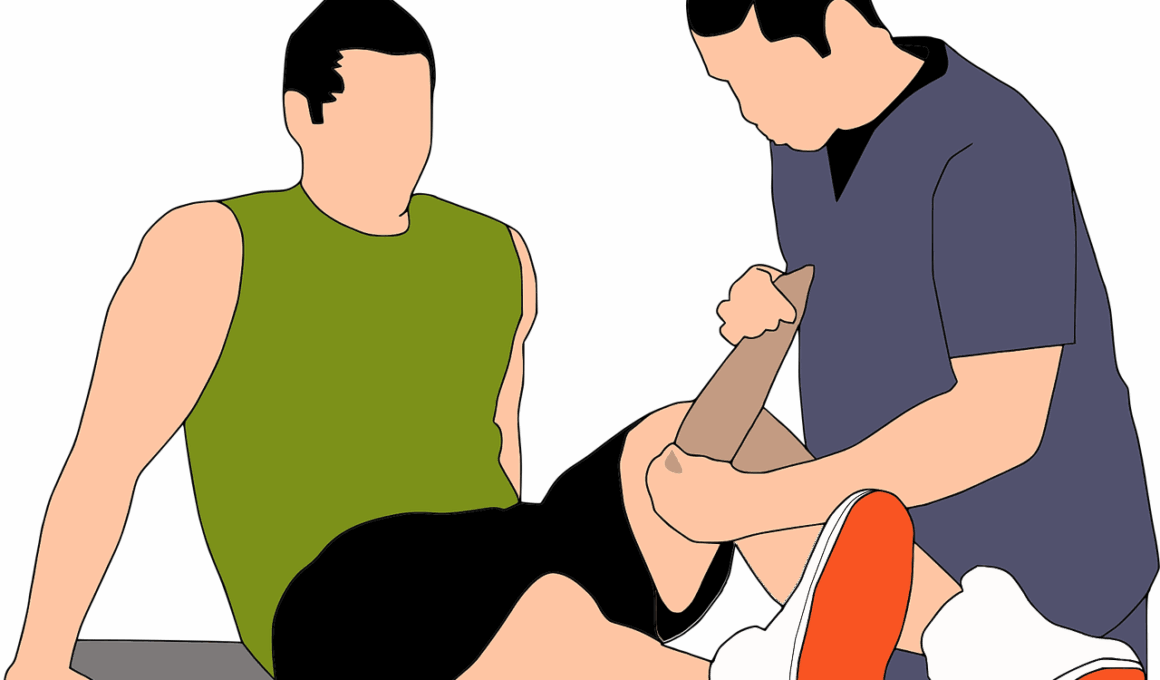Case Studies: Successful Injury Prevention through Taping
Taping is a widely utilized technique in sports medicine that involves applying adhesive tape to athletes’ bodies to provide support and stability. The purpose of taping is to prevent injuries or help in the rehabilitation process. There are several methods for taping, including rigid taping, elastic taping, and kinesiology taping. Each method serves a specific purpose and techniques vary based on the type of injury being treated. Rigid taping is often used for sprains and strains, whereas elastic taping allows for more movement, aiding recovery while providing support. Kinesiology taping, a method developed in the 1970s, promotes healing by facilitating the body’s natural healing processes. This is achieved by reducing pain and inflammation, enhancing proprioception, and improving circulation. Evaluating the effectiveness of these taping methods through clinical case studies establishes their role in injury prevention. This article outlines various successful cases highlighting athletes who benefitted from these techniques in maintaining their performance levels and preventing severe injuries. Ultimately, understanding these cases can aid practitioners in making informed decisions regarding taping and bracing in sports settings.
In a notable case involving a professional football player, a routine taping technique was employed to prevent ankle sprains. Before the season began, the athlete underwent specific training focused on proprioceptive feedback and strength conditioning. Unfortunately, during practice, he experienced a slight roll of the ankle leading to concern about potential injury. A sports therapist immediately applied rigid tape, providing stability and allowing the player to continue practicing without discomfort. This quick intervention not only prevented a severe sprain but also helped maintain his confidence in his footwork. Following this experience, the player reported a significant decrease in anxiety during practices and games when taped. He credited the taping with allowing him to focus on performance rather than worrying about injury. This case demonstrates how proactive taping can effectively mitigate injury risk while contributing positively to the athlete’s mindset. Coaches and trainers can learn valuable lessons from this player’s experience, reinforcing the need for timely taping interventions as part of preventive sports medicine practices. The integration of such techniques into training programs can optimize athlete performance and minimize the occurrence of common injuries on the field.
Case Study: Successful Use of Kinesiology Taping
Another fascinating case study highlights the effectiveness of kinesiology taping among a group of elite runners. A running coach noticed that several athletes were struggling with recurring patellar tendon pain, which hindered their training and competitive performance. To address this issue, the coach enlisted the help of a sports physiotherapist who introduced kinesiology taping techniques specifically targeting the knee joint area. The taping involved applying strips of elastic tape to the patellar region in a way that encouraged proper biomechanical movement and reduced pressure on the tendon. Over the course of six weeks, data collected demonstrated significant improvements in pain levels reported by the athletes. Additionally, training sessions showed increased duration and intensity without discomfort. These findings suggest that kinesiology taping may play a vital role in safely managing pain while allowing athletes the opportunity to continue their training. The runners, feeling empowered by the support of the taping, experienced enhanced performances during competitions with minimal discomfort. Such cases should encourage sports medicine practitioners to consider kinesiology taping as an effective tool for injury management and prevention strategies in athletic populations.
A comparative case study involving two basketball players, one with and one without taping, provides critical insights into injury prevention. The first player, who had a history of ankle sprains, used rigid taping prior to each game, while the second player opted not to tape. Both players underwent similar strength training and agility drills, but observations during the competitive season revealed stark differences. The taped player experienced no incidents of ankle sprains, while the untaped player sustained two sprains leading to missed games. The taped athlete attributed his success to greater stability and confidence from the supportive adhesive. Feedback from the coaching staff indicated enhanced overall performance from the taped player, showcasing minimal hesitation while executing challenging maneuvers. Data from this case study suggests that incorporating regular taping into training regimens could translate to fewer injuries, allowing athletes to maintain consistent performance throughout the season. This example illustrates the necessity of enhancing preventative care strategies through tailored approaches such as dynamic taping, ultimately leading to increased athlete availability and improved team success.
The Role of Bracing in Sports Medicine
In addition to taping, bracing is another integral method in sports medicine, providing effective injury prevention and rehabilitation. Braces offer more rigid support compared to tape and are commonly used for injuries involving ligaments and joints. A prominent case involved a soccer player recovering from an ACL tear. To facilitate a successful return to play, a knee brace was recommended during rehabilitation sessions. The brace allowed the athlete to regain confidence in their movements while practicing agility drills. Gradually, the player adjusted to the restrictions imposed by the brace, enhancing strength in surrounding musculature. Notably, during practice matches, the player experienced no recurrence of instability or pain. Properly fitted braces can play a significant role in stabilizing joints and protecting athletes during the recovery phase. Evaluating the experiences of athletes using bracing techniques emphasizes the importance of combining approaches for a results-oriented rehabilitation process. Therefore, professionals in sports medicine should consider integrating braces into their preventive protocols as they offer an alternative option for athletes needing additional support while returning to sports following injury.
Exploring the interplay between taping and bracing techniques, another case involved a volleyball player prone to shoulder injuries. Despite preventive training measures, recurring pain from overuse led to a performance decline. A sports physician introduced a dual approach: using kinesiology tape alongside a shoulder brace. The objective was to facilitate joint stability while permitting mobility during play. This innovative combination allowed the athlete to remain actively engaged in practices without exacerbating discomfort. Over a three-month period of consistent taping and bracing, the player noted a marked reduction in pain, significantly enhancing her performance capabilities. Trainers reported improvements in agility and precision while executing complex plays during matches. The athlete’s psychological state also improved as she regained trust in her shoulder’s functionality. Analyzing this case showcases the effectiveness of utilizing both taping and braces synergistically for injury prevention. This versatile strategy can be advantageous for athletes working through rehabilitative phases, promoting a successful transition back to maximum performance levels. The evolution of treatment protocols highlights the need for ongoing research in assessing optimal combinations of techniques within sports medicine settings.
Conclusion and Future Directions
In conclusion, the case studies outlined within this article illustrate the profound impact of taping and bracing techniques in sports medicine. Athletes from various sports have demonstrated the effectiveness of these methods for preventing injuries and facilitating recovery. Incorporating timely and appropriate taping, along with supportive braces, should be emphasized throughout athletic training programs. Furthermore, understanding these individual cases allows practitioners to develop evidence-based protocols for injury management tailored to specific needs. Encouraging collaborative efforts between coaches, physiotherapists, and sports medicine professionals can enhance the overall effectiveness of preventative strategies. As research continues to evolve in the realm of sports injury prevention, the need for innovative approaches will become paramount. Future studies should focus on identifying the most beneficial taping and bracing combinations for various injuries, examining athlete experiences, and quantifying performance outcomes. Expanding on these findings can lead to the development of comprehensive preventive frameworks that enhance athlete longevity and well-being. Adopting a proactive stance toward injury prevention can ultimately contribute to a safer sporting environment and improved athletic performance across disciplines.
Through the amalgamation of various case studies, the role of taping and bracing techniques in enhancing athletic performance and reducing injury risk becomes increasingly clear. Athletes should work with knowledgeable professionals who can guide them through the selection and application of these techniques. Emphasizing individualized approaches, along with continuous monitoring of athletes’ feedback, can lead to more effective injury prevention tactics. Sports teams, coaches, and health professionals should share their insights and experiences with these techniques and foster a culture of safety and support. Engaging in open dialogue encourages the seamless integration of taping and bracing protocols within athletic training programs while maximizing the benefits for the athletes involved. It is crucial that athletes feel empowered to share their concerns regarding discomfort or previous injuries. By addressing these issues thoughtfully, practitioners can modify treatment plans and explore alternative methods that best suit the athlete’s needs. Ultimately, the journey towards improving sports injury prevention systems lies in the commitment to ongoing education, research, and collaboration. With a united effort, it’s possible to create an optimized performance environment while prioritizing athletes’ health and safety.


